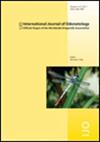On the firing line – interactions between hunting frogs and Odonata
IF 1
4区 农林科学
Q3 ENTOMOLOGY
引用次数: 7
Abstract
Frogs are important predators of Odonata. We investigated frogs catching Odonata prey by means of slow-motion filming in the field in order to understand the prey–predator interactions. In particular, we aimed to analyse kinematics of captures, and of Odonata fleeing, through evaluation of frame-by-frame filming; 122 (20%) of 613 events were analysed. While dragonflies were ovipositing, frogs were sitting and waiting motionless, or they sneaked slowly towards the intended prey. The speed of the lashing tongue was much higher than the start and flight velocities of Odonata during escape attempts. The reaction time of Odonata was around 45×10–3 s, and it was not correlated to capture rate. The fleeing behaviour of Odonata cannot be considered to be stereotypical. The usual fleeing measure was to evade sideways to the jump direction of the frog, with the individual turning their body to one side and flying away from the frog. Perched odonates escaped by overturning to one side, sometimes falling into the water, or by flying in a loop. To escape, individuals were observed flying backward with the head down, in two cases. From the video clips, capture rates were counted. Large Anisoptera escaped more often than small Zygoptera. Anax imperator females mostly escaped after capture by fighting with strong wing beats, even when pulled under water by the frog.在火线上——捕猎的青蛙和蛇蜥之间的相互作用
青蛙是蛙类的重要捕食者。为了了解蛙类捕食者与猎物之间的相互作用,我们采用慢镜头拍摄的方法对蛙类捕食蛇的过程进行了实地调查。特别是,我们旨在通过逐帧拍摄的评估来分析捕获和奥多纳塔逃跑的运动学;对613例事件中的122例(20%)进行了分析。当蜻蜓产卵时,青蛙坐在那里一动不动地等待着,或者它们慢慢地偷偷地走向预定的猎物。鞭笞舌头的速度远远高于奥多纳塔在逃跑时的起跑速度和飞行速度。Odonata的反应时间约为45×10-3 s,与捕获率无关。奥多纳塔的逃跑行为不能被认为是典型的。通常的逃跑方法是侧身躲避到青蛙的跳跃方向,个体将身体转向一边,从青蛙身边飞走。栖息的齿鲨通过翻到一边,有时掉进水里,或绕圈飞行来逃脱。为了逃跑,在两种情况下,观察到个体低着头向后飞行。从视频片段中,计算捕获率。大的异翅目比小的叉翅目更常逃脱。雌Anax imperator在被捕获后,即使被青蛙拉到水下,也会用强有力的翅膀搏击来逃脱。
本文章由计算机程序翻译,如有差异,请以英文原文为准。
求助全文
约1分钟内获得全文
求助全文
来源期刊

International Journal of Odonatology
ENTOMOLOGY-
CiteScore
2.30
自引率
0.00%
发文量
15
审稿时长
>12 weeks
期刊介绍:
International Journal of Odonatology (IJO) is aimed at providing a publication outlet for the growing number of students of Odonata. It will address subjects such as the ecology, ethology, physiology, genetics, taxonomy, phylogeny and geographic distribution of species. Reviews will be by invitation, but authors who plan to write a review on a subject of interest to the journal are encouraged to contact the editor.
 求助内容:
求助内容: 应助结果提醒方式:
应助结果提醒方式:


